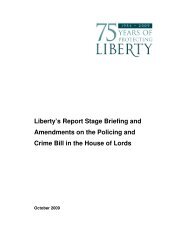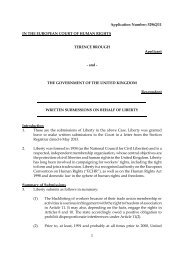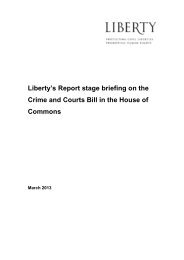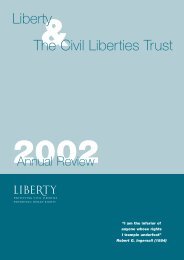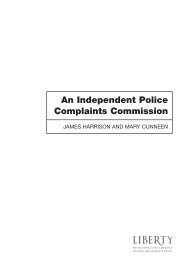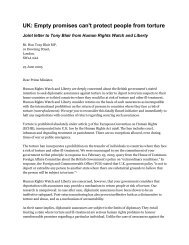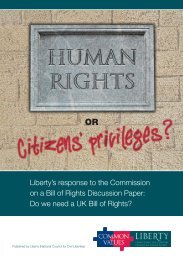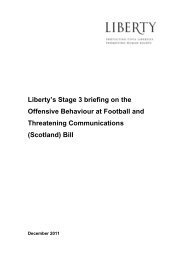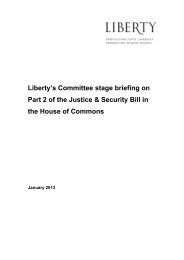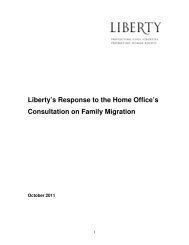Overlooked - Liberty
Overlooked - Liberty
Overlooked - Liberty
Create successful ePaper yourself
Turn your PDF publications into a flip-book with our unique Google optimized e-Paper software.
112 <strong>Overlooked</strong>: Surveillance and personal privacy in modern Britain<br />
4) The legislative framework regulating privacy is unsuited to current requirements. In relation to the<br />
DPA this is due to development of the common law (in particular relating to CCTV as a<br />
consequence of Durant) and as a consequence of increased capability in automated data<br />
processing. In human rights terms this is mainly due to the HRA 1998 being ideally suited to<br />
provide redress to the individual victim. Inroads into privacy will often have an impact upon<br />
society as a whole. However the HRA is not best equipped to provide such a wide analysis. This<br />
limitation to HRA litigation is of particular relevance to the rollout of the National DNA database<br />
which tends to pit the benefit of solving a specific serious crime against a less quantifiable cost<br />
to wider public privacy.<br />
Intrusive Surveillance<br />
1) RIPA falls short of providing a proper accountability mechanism. The most significant<br />
shortcoming is the failure of RIPA to provide any independent judicial scrutiny of applications for<br />
intrusive surveillance. Nearly seven years after coming into force, RIPA continues to be criticised<br />
for its complexity and the difficulties of interpretation.<br />
2) The regulatory framework for RIPA does not allow comprehensive scrutiny of intrusive<br />
surveillance. The Office of Surveillance Commissioners has expressed concerns that the lack of<br />
training and awareness among RIPA empowered agencies could lead to unlawful interference<br />
with privacy. Reports by the Interception of Communications Commissioner have expressed<br />
concern over the numbers of mistakes made during RIPA authorisation. His most recent report<br />
also demonstrated the sheer volume of authorisations (over 439,000 in the 15 months between<br />
January 2005 and March 2006) making consideration of individual authorisation difficult. This is<br />
compounded by the fact that these two surveillance watchdogs mainly operate in a reviewing<br />
capacity, commenting on what has happened previously. The Regulation of Investigatory Powers<br />
Tribunal also seems unsuited to fulfil a meaningful role in determining complaints. Its inability to<br />
consider investigations not authorised by warrant has contributed to a failure to make a single<br />
determination of contravention of the HRA or RIPA.<br />
3) The certified warranting process allows the mass examination of external communications (those<br />
sent or received outside the UK). RIPA also permits the Secretary of State to authorise certified<br />
warranting practices to occur within the UK. It is unclear the extent to which mass surveillance<br />
of internal communications takes place.<br />
4) A consequence of increasing reliance on data matching and data mining techniques might result<br />
in a knock-on effect increasing the quantity of authorisations of low-level RIPA powers like<br />
accessing communications data.<br />
5) The Government has not given any indication that it intends to change the authorisation regime<br />
for interception of communications. As a consequence, ministerial oversight is likely to remain in<br />
place for the time being. However, there is growing interest in judicial authorisation as evidenced<br />
by the recommendation of the Joint Committee on Human Rights in its report on counter<br />
terrorism policy that it should be adopted 217 .<br />
217<br />
See Page 36 above.



